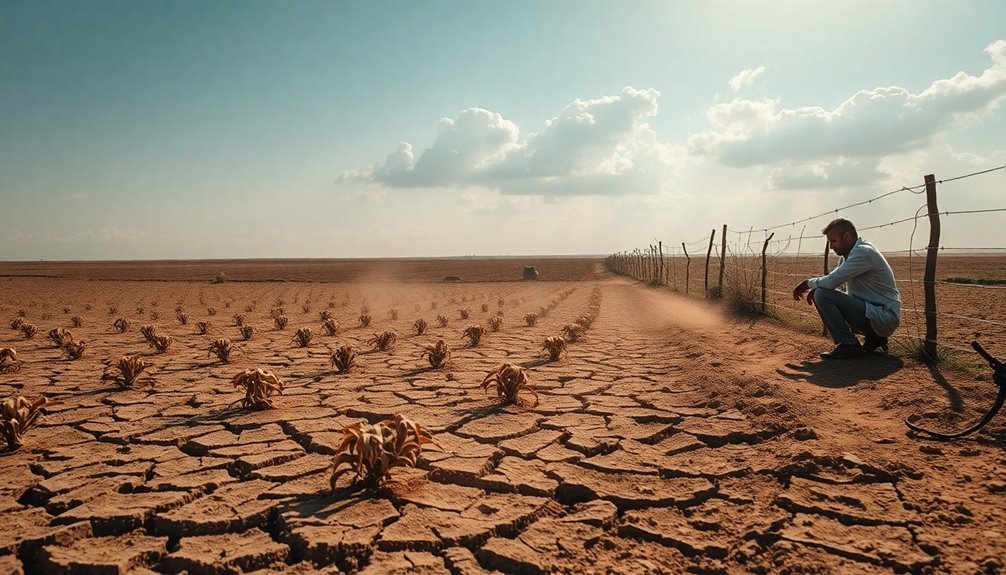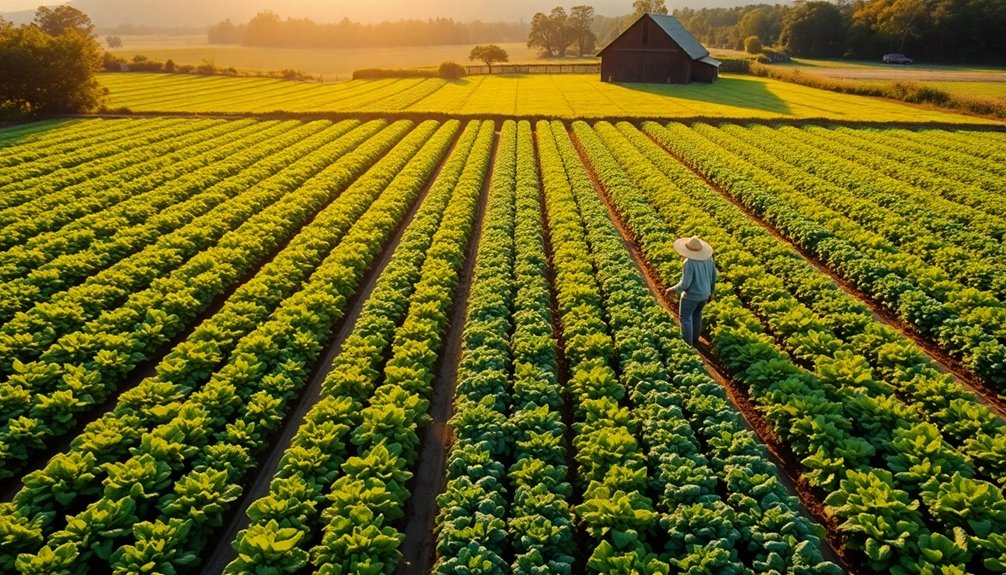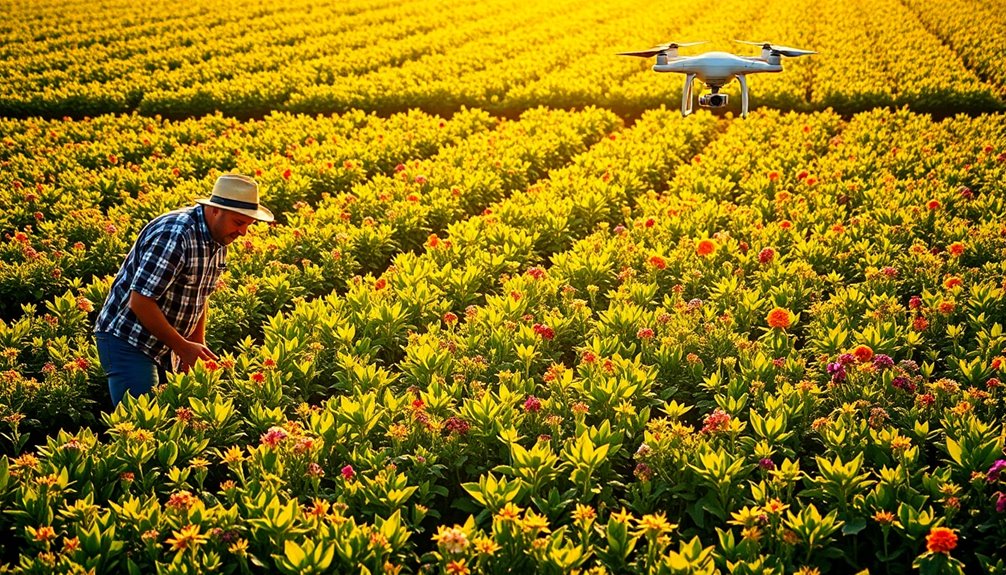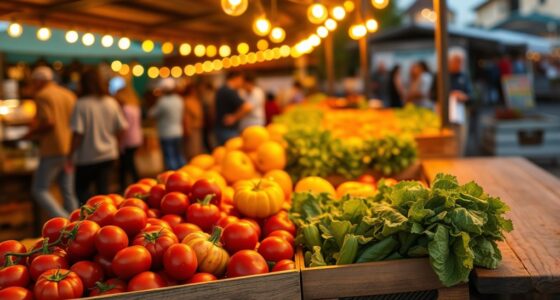Unsustainable farming practices are a major cause of desertification and can severely affect soil health. Overgrazing depletes grasslands, washing away essential topsoil. Monocropping and continuous cropping strip nutrients, making the land less fertile over time. Relying heavily on chemical fertilizers harms microbial communities, leading to soil acidification. Poor irrigation methods contribute to salinization, rendering irrigated areas unusable. As these practices continue, they degrade the environment and threaten food security. Understanding how these farming methods impact land can help you make better choices. Stick around to uncover more about the interplay between farming and desertification.
Key Takeaways
- Unsustainable farming practices like overgrazing and monocropping significantly degrade soil quality and contribute to desertification.
- Continuous cropping without fallow periods depletes essential soil nutrients, worsening soil fertility and leading to erosion.
- Reliance on chemical fertilizers disrupts microbial communities and increases soil acidity, further degrading agricultural land.
- Poor irrigation practices, such as excessive watering, result in salinization, affecting crop yields and long-term soil viability.
- Habitat destruction from farming reduces biodiversity, weakening ecosystem resilience and complicating recovery from climate impacts.
Understanding Desertification
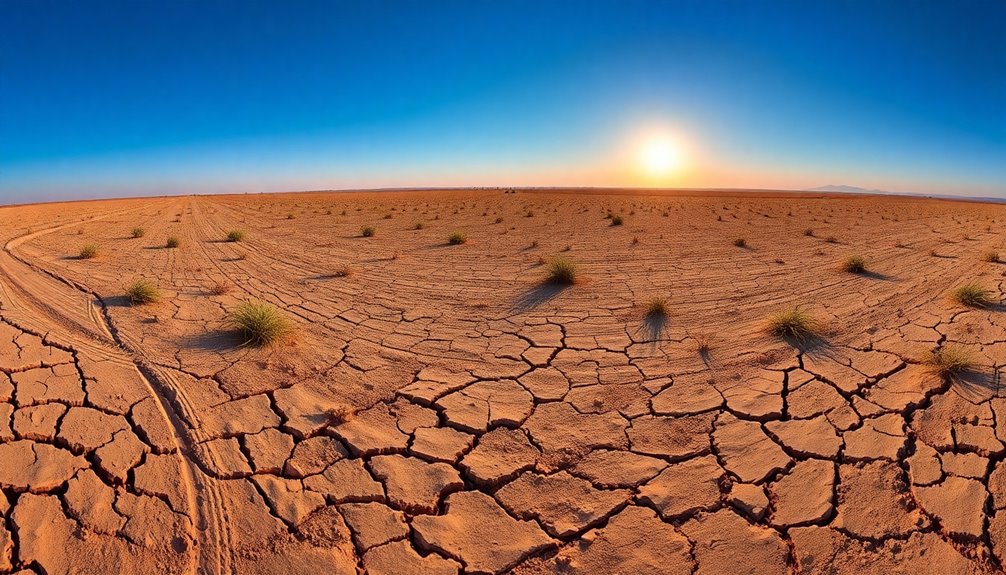
Have you ever wondered how desertification transforms once-fertile land into barren wastelands? It primarily stems from soil degradation and unsustainable farming practices.
Overcultivation and monocropping strip the land of its natural vegetation cover, disrupting local ecosystems and diminishing agricultural productivity. Improper irrigation can lead to salinization, affecting about 20% of irrigated land and further diminishing its viability.
You might be surprised to learn that soil erosion, accelerated by inadequate land management, results in the annual loss of 25-45 billion tons of soil globally. Overgrazing by livestock compounds these issues, causing soil compaction and reducing moisture retention.
Climate change-induced factors exacerbate water stress, leading to severe land degradation in arid areas and ultimately fueling the cycle of desertification.
Key Farming Practices Contributing to Desertification
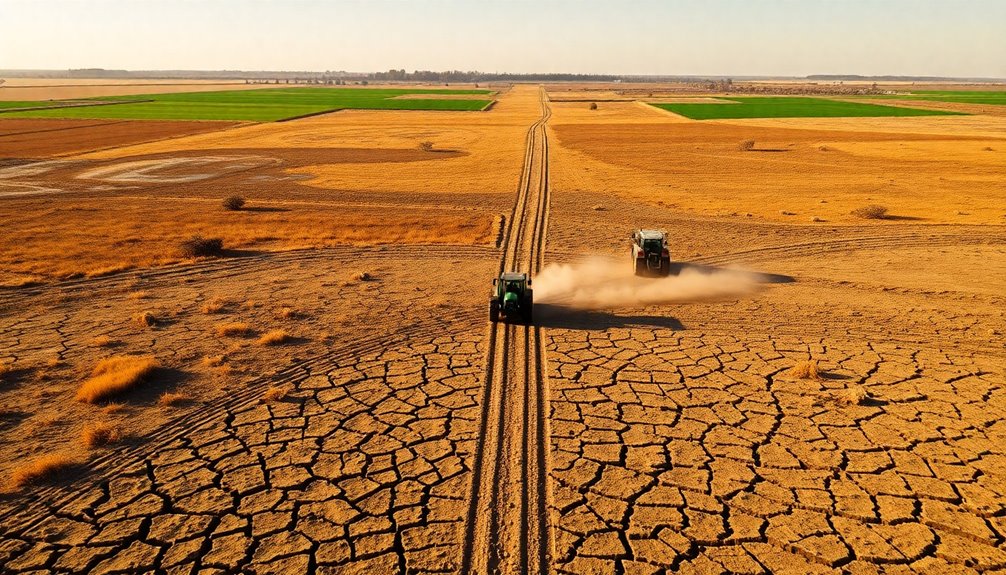
When you engage in unsustainable farming practices, like overgrazing and monoculture, you're risking the health of the land.
These techniques not only degrade soil quality but also lead to severe erosion and nutrient loss.
Understanding how these actions contribute to desertification is essential for promoting healthier agricultural methods.
Overgrazing Consequences
Overgrazing, a common farming practice, greatly contributes to desertification by devastating vegetation essential for soil health.
The destruction of vegetation leads to significant soil erosion, with vulnerable regions losing an estimated 30-40 tons of soil per hectare annually. This compaction diminishes the soil's moisture retention, worsening drought and reducing biological productivity in dryland ecosystems.
Additionally, overgrazing degrades grazing lands; studies indicate that 30% of irrigated drylands face moderate to severe degradation.
With protective vegetation stripped away, soil becomes exposed to wind and water erosion, triggering desertification and the formation of sand dunes.
Ultimately, this practice not only harms soil health but also causes a loss of biodiversity, making habitats uninhabitable for various species.
Unsustainable Cultivation Techniques
Unsustainable cultivation techniques pose a significant threat to land health and contribute to desertification.
Practices like overcultivation, where you plant crops continuously without allowing for fallow periods, deplete soil nutrients and lead to soil degradation.
Inadequate irrigation practices, such as over-irrigation, can cause waterlogging and salinization, severely harming soil structure and crop yields.
The excessive use of chemical fertilizers disrupts soil microbial communities, resulting in decreased soil fertility and increased erosion susceptibility.
Each year, 23-42 million tons of nitrogen and 12-22 million tons of phosphorus are lost due to erosion from these techniques, negatively impacting food production.
Addressing these unsustainable practices is essential for maintaining soil health and preventing further desertification.
The Role of Overgrazing
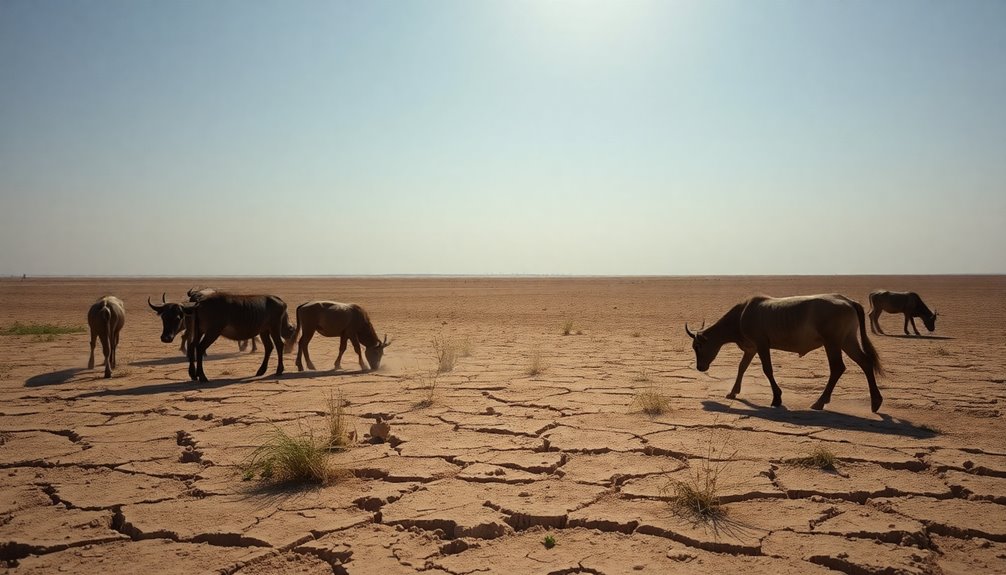
Livestock can quickly turn lush pastures into barren landscapes through the practice of overgrazing. When animals consume vegetation faster than it can regenerate, significant vegetation destruction occurs, leading to soil erosion and land degradation.
This process is responsible for about 70% of the degradation of grazing lands globally, disrupting ecosystems and causing a loss of biodiversity. In arid and semi-arid regions, overgrazing reduces soil fertility, which directly decreases agricultural productivity and threatens food security.
The compaction of soil from hooves limits its ability to retain moisture, worsening drought conditions and accelerating desertification. Ultimately, overgrazing creates a harmful feedback loop that makes it increasingly challenging to restore affected ecosystems, further endangering the land's health and sustainability.
Unsustainable Agricultural Techniques
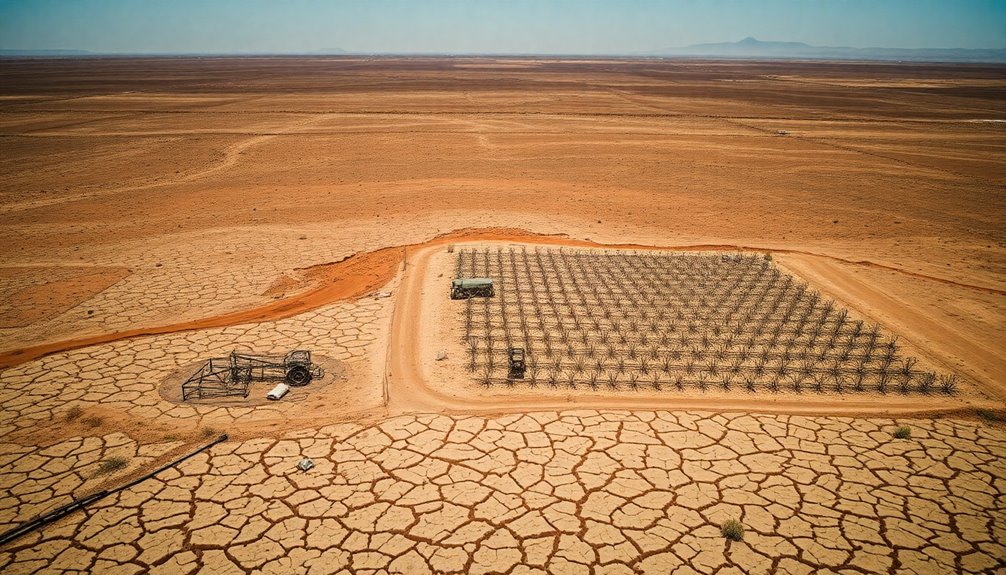
Many agricultural practices today contribute greatly to desertification, threatening both the environment and food security.
Unsustainable agricultural practices, like monocropping and overcultivation, lead to soil degradation and nutrient depletion, causing yield losses of 2%-40% for small-scale farms in Africa.
When you rely on chemical fertilizers without proper management, you risk soil acidification and increased salinity, further exacerbating land degradation.
Poor irrigation techniques can cause waterlogging and salinization, affecting about 20% of irrigated land globally.
Additionally, the expansion of cropland into untouched areas results in habitat destruction and soil compaction, undermining ecosystem resilience in dryland areas.
These factors collectively accelerate desertification, making it essential to adopt sustainable practices for a healthier planet.
Climate Change Interactions

Climate change is making droughts more frequent and intense, and you can see its effects on dryland ecosystems firsthand.
As temperatures rise, you may notice that soil moisture dwindles, threatening agricultural viability.
Understanding these climate variability effects is essential for addressing the challenges of desertification.
Climate Variability Effects
In dryland ecosystems, the effects of climate variability are becoming increasingly evident, as prolonged droughts and rising temperatures weaken biological productivity. This decline contributes notably to desertification, threatening agricultural production and the livelihoods of communities.
- Increased frequency of extreme weather events
- Reduced soil conservation capabilities
- Escalating global warming impacts
- Enhanced vulnerability of arid and semiarid regions
As climate change intensifies, these factors exacerbate already fragile conditions, leading to an alarming projection of a 30% loss of arable land within the next 25 years.
The interplay between climate variability and desertification jeopardizes food security, compelling you to ponder sustainable practices that mitigate these challenges. By understanding these causes of desertification, you can contribute to more resilient agricultural practices in vulnerable areas.
Drought Frequency Increase
Droughts are becoming more frequent and intense as climate change unfolds, posing a serious threat to dryland ecosystems. This increase in drought frequency leads to significant soil moisture depletion, which directly impacts agricultural productivity.
As climatic changes escalate, the biological productivity of these regions declines, heightening the risks of desertification. Extended drought conditions contribute to soil degradation and erosion, diminishing the quality of arable land.
In addition, persistent droughts make ecosystems more vulnerable to extreme weather events, complicating recovery efforts. Projections indicate that average annual warming could rise by 3–5°C over the next century, exacerbating these challenges.
To combat these issues, sustainable land management practices are essential for maintaining the health of our ecosystems.
Long-term Impacts on Ecosystems
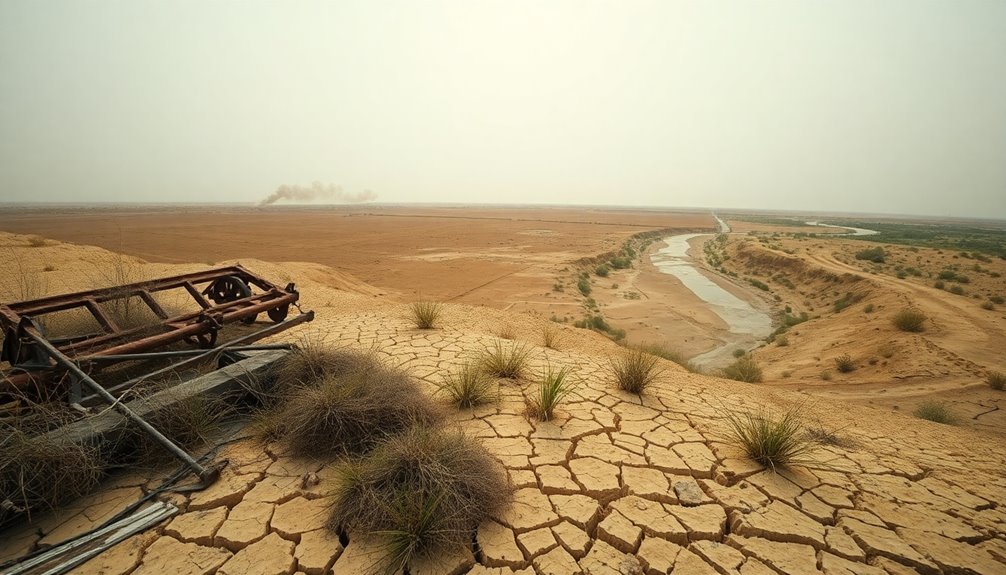
Desertification doesn't just transform landscapes; it profoundly affects ecosystems over the long term.
- Soil degradation leads to reduced productivity of the land.
- Water availability diminishes, impacting plant and animal life.
- Human activities accelerate habitat destruction and species loss.
- Climatic changes exacerbate these effects, creating uninhabitable environments.
As unsustainable farming practices like overcultivation and monocropping continue, soil quality declines, resulting in severe biological productivity loss.
Erosion strips away 30 to 40 tons of soil per hectare annually, threatening food security.
Additionally, salinization of 20% of irrigated land disrupts ecological balance, reducing crop yields and biodiversity.
With habitats vanishing, species struggle to adapt, ultimately leading to a cyclical decline in ecosystem resilience, making recovery from extreme weather increasingly difficult.
Frequently Asked Questions
Which Is a Cause of Desertification in Farming?
When you consider farming practices, unsustainable methods often lead to desertification.
If you rely on overcultivation or monoculture, you're depleting soil nutrients and reducing biodiversity.
Poor irrigation techniques can cause salinization, harming soil productivity.
Converting forests or grasslands into agricultural land can destroy habitats and compact soil, further worsening the situation.
It's vital to adopt sustainable practices to protect the land and guarantee food security for the future.
Which Is a Cause of Desertification in Quizlet?
When you think about desertification, have you ever considered what might be lurking beneath the surface?
One major cause is unsustainable farming practices. These practices, such as overcultivation and monoculture, weaken soil quality and lead to severe nutrient depletion.
You mightn't realize that nearly 20% of irrigated land suffers from salinization, making it less arable.
As you explore this topic further, the connection between farming and desertification becomes clearer and more alarming.
Which of the Following Is the Main Cause of Desertification?
When you consider the main cause of desertification, unsustainable farming practices stand out.
You might overcultivate land or rely heavily on chemical fertilizers, which can degrade soil quality. By removing vegetation for agricultural purposes, you expose the soil to erosion and reduce its moisture retention.
Additionally, overgrazing can lead to soil compaction. Together, these actions contribute greatly to land degradation, making it increasingly difficult for the land to recover.
Conclusion
As you reflect on the farming practices we've explored, consider the stark reality of desertification creeping closer. Every choice you make in agriculture can either nurture the land or push it toward a barren fate. What happens if we ignore the signs? The balance of ecosystems hangs in the balance, and the clock is ticking. Will you be part of the solution or the problem? The future of our planet may hinge on the decisions you face today.

